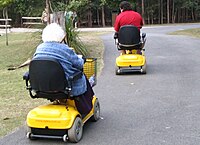
Photo from wikipedia
Background: In December 2009, a cluster of patients with pneumonia was reported in the city of Wuhan, capital of Hubei province in China, caused by a novel coronavirus: SARS-CoV-2 The… Click to show full abstract
Background: In December 2009, a cluster of patients with pneumonia was reported in the city of Wuhan, capital of Hubei province in China, caused by a novel coronavirus: SARS-CoV-2 The epidemiological compartmental susceptible-exposed-infected-recovered (SEIR) model has been previously used during the initial wave of the H1N1 influenza pandemic in 2009 This study investigates whether the SEIR model, associated to mobility changes parameters, can determine the likelihood of establishing control over an epidemic in a city, state or country Methods: The critical step in the prediction of COVID-19 by a SEIR model are the values of the basic reproduction number (R0) and the infectious period, in days R0 and the infectious periods were calculated by mathematical constrained optimization, and used to determine the numerically minimum SEIR model errors in a country, based on COVID-19 data until april 11th The Community Mobility Reports from Google Maps (https://www google com/COVID19/mobility/) provided mobility changes on april 5th compared to the baseline (Jan 3th to Feb 6th) The data was used to measure the non-pharmacological intervention adherence The impact of each mobility component was made by logistic regression models COVID-19 control was defined by R0 of the SEIR model in a country less than 1 0 Results: Residential mobility restriction presented the higher logistic coefficient (17 7), meaning higher impact on outbreak control Workplace mobility restriction was the second most effective measure, considering a restriction minimum of 56% for a 53% chance of outbreak control Retail and recreation mobility presented 53%, and 86% respectively Transit stations (96% and 54%) were also assessed Park mobility restriction demonstrated the lowest effectiveness in outbreak control, considering that absolute (100%) restriction provided the lowest chance of outbreak control (46%) Conclusion: Residential mobility restriction is the most effective measure The degree to which mobility restrictions increase or decrease the overall epidemic size depends on the level of risk in each community and the characteristics of the disease More research is required in order to estimate the optimal balance between mobility restriction, outbreak control, economy and freedom of movement (Table Presented)
Journal Title: Open Forum Infectious Diseases
Year Published: 2020
Link to full text (if available)
Share on Social Media: Sign Up to like & get
recommendations!